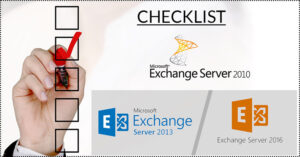When users delete a mailbox from Exchange, it becomes inactive and moves to a soft delete state for a limited time (default 30 days). After 30 days, the mailbox permanently disappeared from Microsoft Exchange. Sometimes, organizations need to restore inactive mailboxes in MS Exchange for various scenarios.
Organizations look to restore mailboxes in various conditions, like when an employee leaves and you need critical data. Moreover, restoring mailboxes is also necessary if a new employee joins and requires old data, if the employee whose data restoring has rejoined the organization, or if organizations need data for legal purposes.
This article will share the solution to restore inactive mailboxes in Microsoft Exchange, both On-Premises and Online. Users will get the complete stepwise procedure to complete this mailbox restoring task, so read this article and complete this task.
Solutions to restore deactivated mailbox in Microsoft Exchange
Users cannot use the Exchange Admin Center to restore inactive mailboxes in MS Exchange. Users must follow the PowerShell commands for Exchange On-Premises and Online. The following section will share the step-by-step guide to retrieving disconnected Exchange mailboxes.
Instructions to Restore Mailbox in Exchange On-Premises
This solution will provide the necessary PowerShell commands to restore inactive mailboxes in Exchange On-Premises. Following each step carefully is required to complete this task without any hassle.
- Launch the Exchange Management Shell on your device.
- Now, get the list of inactive mailboxes by running the below script.
Get-MailboxDatabase | Get-MailboxStatistics | Where-Object { $_.DisconnectDate -ne $null } | Select-Object DisplayName,Database,DisconnectDate- After that, you can see the list of inactive mailboxes that can be restored using the following command.
Connect-Mailbox -Identity "<MailboxGuid>" -Database "<DatabaseName>" -User "<UserName>"Once you complete these steps, the mailbox will be restored and easily accessible. Then, check if the mailbox is accessible or not and verify the mailbox data. Now, let us understand how to restore inactive mailboxes in Exchange Online.
Retrieving Disconnected Mailbox in MS Exchange Online
Users can reconnect inactive mailboxes in Exchange Online using a few simple steps. Follow each step carefully and restore mailboxes effectively.
- First of all, open the Microsoft Exchange Online PowerShell.
- Then, run the command to connect to the Exchange Online.
$UserCredential = Get-CredentialConnect-ExchangeOnline -UserPrincipalName $UserCredential.Username -Password $UserCredential.Password- Now, list all the inactive mailboxes with the help of the following command.
Get-Mailbox –SoftDeletedMailbox- Use the below script to restore inactive mailboxes in Office 365 or Exchange Online.
New-MailboxRestoreRequest -SourceMailbox "<MailboxGuid>" -TargetMailbox "<UserMailbox>"- Check the restoring progress by running this command.
Get-MailboxRestoreRequestAfter performing these steps, users can easily access the inactive mailbox in Exchange Online. Moreover, ensure the mailbox data is restored and easily accessible using the Outlook email client.
We recommend regularly backing up Exchange data to avoid situations where you need to restore inactive mailboxes. The next section will share a professional solution for users to backup, restore, and recover their Exchange mailboxes.
A Professional Way to Restore MS Exchange Mailboxes
Shoviv Exchange Recovery Manager is professional software that permits users to perform various tasks. This task can easily backup Exchange mailboxes in numerous file formats, including PST, EML, MSG, HTML, etc. Moreover, users can also restore and recover their mailboxes using this third-party tool. This software is masterful at recovering corrupted EDB files while keeping the folder hierarchy original.
Besides this, users can also perform migration tasks from Exchange to Office, Exchange to Exchange, etc. This software is easy for every user, even if they are not from a technical background. Using this tool, users can quickly restore, back up, and recover multiple mailboxes. Also, it allows users to backup, repair, and recover public folders and archive mailboxes with ease.
Also Read: How to Open/View EDB file Freely?
Wrapping Up:
Users can’t restore inactive mailboxes after the retention period. Additionally, restoring mailboxes is also challenging and can be risky for users’ data. Therefore, it would be better to have a regular backup of your important data and avoid taking risks with it. For this, we suggest users use the Shoviv Exchange Recovery Manager Tool, which is easy to handle for everyone. It also has numerous features that help users do their tasks effectively. This tool’s demo version allows users to check its capability by processing the first 50 items per folder freely.
- How to Backup and Restore Emails in Webmail? - March 25, 2025
- How to Migrate Outlook to New Computer? - February 15, 2025
- Fix If Outlook Cannot Display the Specific Folder Location - February 1, 2025


